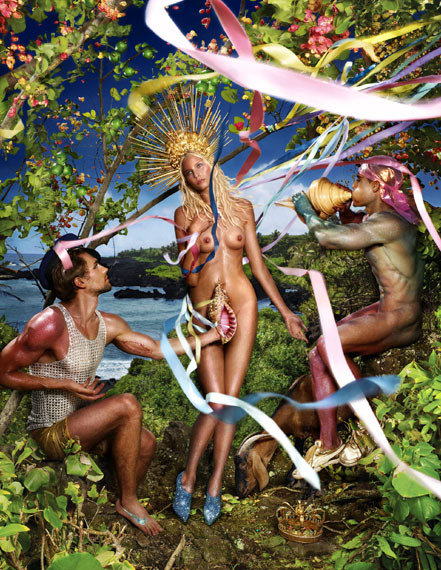David LaChapelle
dal 31/5/2014 al 13/9/2014
Segnalato da
31/5/2014
David LaChapelle
OstLicht Galerie fur Fotografie, Wien
For his fantastic exaggerated, flashy photographs the storyteller has staged numerous pop and movie stars. He creates a bizarre tension between alienation and attraction that raises spirituality and religion, gender and sexuality, transience and exploitation.

During the past three decades, David LaChapelle has created an extraordinary and unmistakeable
oeuvre. He has worked with innumerable pop and film stars, and his powerful, provocative,
humorous, glamorous, but also surreal and usually extremely colourful works have had a lasting
influence on the world of photography and the aesthetics of the visual realm.
The gallery OstLicht presents the exhibition DAVID LACHAPELLE. ONCE IN THE GARDEN, featuring
well-known icons of the last twenty years like Amanda Lepore: Addicted to Diamonds, Celebrity
Gleam and Amanda as Andy Warhol’s Liz Taylor alongside three of his latest groups of works: Earth
Laughs in Flowers, Gas and Land Scape.
Through his exploration of subjects like spirituality and religion, personality cult and physicalness,
and by questioning social norms of gender and sexuality, David LaChapelle has managed to influence
public awareness. He is not a photographer in the classical sense – rather, he is an image-maker, a
storyteller. His visual world is inspired by widely divergent sources like pop culture, the baroque and
renaissance world, art history, movies, pornography and even the Bible. David LaChapelle is a master
of posing existential questions by utilising commonplace props of the consumer world to create
hyper-real settings featuring gleaming and perfect bodies, and by creating an almost bizarre tension
between alienation and attraction. Nature as the foundation of our being, confronting each of us in
our nakedness, is present as a formative element in the artist’s recent work.
In the series Earth Laughs in Flowers (2008-2011) LaChapelle deals with the transience of life and
beauty, borrowing from floral still lifes of the baroque era. In the realm of this Vanitas imagery,
plants, fruits and objects testify to the vanity and finite nature of life. These traditional emblems,
however, are combined by the artist with objects of daily life that are only noticed at second glance:burning cigarettes, old mobile phones, electronic appliances or plastic bottles serve as modern
metaphors of transience in our fast-paced throw-away society.
In his most recent series, Gas and Land Scape, LaChapelle examines global oil production and its
infrastructure, which is anything but sustainable. The photographs show gas stations and refineries in
lighting settings that vary between kitschy and eerily surreal. However, these are not real buildings,
but true-to-scale models made from recycled materials, e.g. egg cartons, computer motherboards,
tea canisters, curlers, straws and other recyclable products manufactured from crude oil. In
elaborate stagings, LaChapelle photographed these models in the rain forest in Maui (Gas Stations),
in the desert and along the Californian coastline (Refineries). This is also an enigmatic commentary by
which LaChapelle wants to inspire the viewer’s self-critical reflection about the relentless
exploitation of our planet: “These buildings are artefacts of a fallen civilization,” he told the magazine
AD in an interview. “If some future archaeologist were to uncover a gas station, like our
archaeologists uncover Incan temples, that would be an indicator of what made this civilization rise
and fall.”
Once in the Garden, finally, is David LaChapelle’s most recent work and is exhibited as part of the
show. Not only did it inspire the title of the OstLicht exhibition, but it is also the title image of the
2014 Life Ball. The diptych makes LaChapelle’s grounding in art history particularly apparent. Motifs
like the pink fountain of life and the reclining youth with a fantasy head are strongly reminiscent of
Hieronymus Bosch’s The Garden of Earthly Delights (ca. 1500). In his own version of a surreal
paradisiacal garden, LaChapelle stages the transgender model Carmen Carrera, giving a strong voice
to an issue close to his heart: that love knows no gender boundaries.
Furthermore, Self Portrait as House, presumably LaChapelle’s most personal work, is shown for the
first time in Europe at OstLicht.
As a kick-off to the exhibition and the Life Ball a poster campaign in cooperation with Gewista with
the images "Once in the Garden (1)" and "Once in the Garden (2)" will take place in public space
starting May 12.
David LaChapelle was born in Connecticut in 1968. He studied fine arts at the North Carolina School
of the Arts. In the mid-1980s he moved to New York. Andy Warhol discovered LaChapelle shortly
thereafter at New York’s legendary Studio 54. LaChapelle began taking photographs for Warhol’s
magazine Interview, and was soon also commissioned by Rolling Stone, Italian Vogue, French Vogue,
GQ and Vanity Fair. His photographic works have been shown at many important museums and
galleries around the world.
The exhibition is accompanied by a catalogue edited by Peter Coeln and Reiner Opoku and published by Brandstätter Verlag (EUR 19.90).
Five percent of the net artwork sales profit will be donated to AIDS LIFE.
Image: Rebirth Of Venus, 2009 © David LaChapelle
Press Contact
Stefan Musil T +43 (0)676 931 66 65 musil@ostlicht.at
Press conference: Saturday, 31.05.2014, 2 pm, David LaChapelle will be present
Opening and summer party of Brotfabrik Wien on Sunday, 01.06.2014, 5 pm, in attendance
of David LaChapelle and DJ Set by Peter Kruder
OstLicht. Galerie für Fotografie
Absberggasse 27, A-1100 Wien
Opening hours:
Gallery: Wed–Sun 12–6 pm, public holidays: 12–6 pm and by appointment
Library: Wed–Fr 12–6 pm
closed on public holidays



